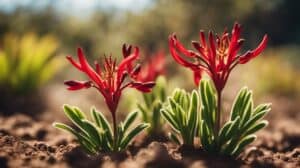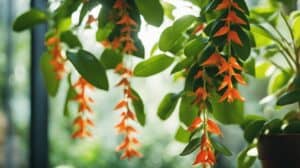The Pink Quill plant, scientifically known as Tillandsia cyanea, is a popular houseplant that is native to the rainforests of Ecuador.
Its unique appearance and low maintenance requirements make it a favorite among plant enthusiasts.
However, many people are unsure about how to propagate the Pink Quill plant.

Propagating the Pink Quill plant is a simple process that can be done through division or offsets.
Division involves separating the plant into smaller sections, while offsets are smaller plants that grow from the base of the parent plant.
By propagating the Pink Quill plant, you can create new plants to share with friends or expand your collection.
In this article, we will discuss the best methods for propagating Tillandsia cyanea and provide tips for proper care.
Understanding Tillandsia Cyanea
Species Overview
Tillandsia Cyanea, commonly known as the Pink Quill Plant, is a species of bromeliad native to Ecuador.
It is a popular ornamental plant due to its attractive pink flowers and ease of care.
The plant belongs to the Tillandsia genus, which includes over 600 species of epiphytic plants.
The Pink Quill Plant is an epiphyte, which means it grows on other plants or objects but does not rely on them for nutrients.
It has a rosette of thin, spiky leaves that can range in color from green to gray.
The plant’s most distinctive feature is its long, thin inflorescence, which can grow up to 12 inches in length and is covered in small, pink flowers.
Native Habitat
Tillandsia Cyanea is native to the rainforests of Ecuador, where it grows on the branches of trees.
It is adapted to living in a humid environment and can tolerate a wide range of temperatures, from 50 to 90 degrees Fahrenheit.
In the wild, the Pink Quill Plant obtains nutrients from the air and rainwater.
It has specialized scales on its leaves called trichomes that absorb moisture and nutrients from the surrounding environment.
This adaptation allows the plant to survive in areas with poor soil quality.
Overall, understanding the natural habitat and characteristics of Tillandsia Cyanea is essential for successful care and propagation of this popular plant.
Fundamentals of Pink Quill Plant Care

Light Requirements
The Pink Quill Plant requires bright, indirect light to thrive.
Direct sunlight can burn the leaves, so it’s best to place the plant near a window that receives filtered light or in a well-lit room.
If the plant doesn’t receive enough light, it can become leggy and lose its vibrant colors.
Watering Techniques
The Pink Quill Plant is an epiphyte, which means it doesn’t require soil to grow. Instead, it absorbs water and nutrients through its leaves.
To water the plant, mist it with a spray bottle or soak it in water for 20-30 minutes once a week.
Make sure to shake off any excess water after soaking to prevent the plant from rotting.
Temperature and Humidity
The Pink Quill Plant prefers temperatures between 60-80°F (15-27°C) and high humidity levels.
It’s important to keep the plant away from cold drafts and heaters, as extreme temperatures can damage the leaves.
To increase humidity, place a tray of water near the plant or use a humidifier.
Overall, the Pink Quill Plant is a low-maintenance plant that adds a pop of color to any space.
By following these simple care instructions, anyone can successfully propagate and care for Tillandsia Cyanea.
Propagation Methods

Propagation of Pink Quill Plants can be done through various methods, including division and offsets.
Division
Division is a popular method for propagating Pink Quill Plants. It involves separating the plant into smaller sections, each with its own roots and leaves.
This method is best done during the plant’s active growing season, which is typically in the spring or summer.
To divide a Pink Quill Plant, gently remove it from its pot and carefully separate the individual sections.
Be sure to use a sharp, sterile tool to avoid damaging the plant.
Once separated, each section can be potted up in a suitable growing medium and treated as a new plant.
Offsets
Another method for propagating Pink Quill Plants is through offsets.
Offsets are small plants that grow off the main plant and can be removed and potted up to create new plants.
This method is also best done during the plant’s active growing season.
To propagate through offsets, gently remove them from the main plant and pot them up in a suitable growing medium.
It’s important to ensure that each offset has its own roots and leaves to ensure its success.
Overall, both division and offsets are effective methods for propagating Pink Quill Plants.
With proper care and attention, these methods can help you create new plants and expand your collection.
Troubleshooting Common Issues

Pest Problems
The Pink Quill plant is susceptible to a few common pests, including mealybugs and spider mites.
If you notice small webs or white cottony masses on the leaves, it’s likely that your plant is infested with spider mites or mealybugs.
These pests can be treated with insecticidal soap or neem oil.
Simply spray the affected areas with the solution and repeat the treatment every few days until the pests are gone.
Be sure to also isolate the affected plant to prevent the infestation from spreading to other plants.
Disease Management
The Pink Quill plant is generally resistant to diseases, but it can still fall victim to root rot if it’s overwatered or if the soil is not well-draining.
To prevent root rot, make sure to allow the soil to dry out between waterings and ensure that the pot has adequate drainage.
If you notice any signs of root rot, such as yellowing or wilting leaves, remove the affected parts of the plant and repot it in fresh, well-draining soil.
Another disease that can affect the Pink Quill plant is leaf spot, which is caused by fungal infections.
If you notice brown or black spots on the leaves, remove the affected leaves and treat the plant with a fungicide.
Be sure to follow the instructions on the fungicide carefully and isolate the affected plant to prevent the spread of the disease to other plants.
By following these tips, you can keep your Pink Quill plant healthy and thriving.
Remember to monitor your plant regularly and take action quickly if you notice any signs of pests or disease.
Frequently Asked Questions

How do I propagate Pink Quill pups?
Propagating Pink Quill pups is relatively easy, and it involves separating the pups from the mother plant once they are large enough.
To do this, gently twist the pup from the mother plant, being careful not to damage the roots.
Then, plant the pup in a well-draining soil mix, and keep it in a warm, humid location until it establishes roots.
Can you propagate Tillandsia Cyanea in water?
While it is possible to propagate Tillandsia Cyanea in water, it is not recommended.
This is because the plant’s roots are adapted to absorb moisture and nutrients from the air, and they may rot if submerged in water for too long.
Instead, it is best to propagate Pink Quill pups by planting them in a well-draining soil mix.
What are the signs of a healthy Pink Quill pup?
A healthy Pink Quill pup should have bright green leaves and a firm, plump appearance.
It should also be growing new leaves and roots, and it should not have any signs of discoloration or wilting.
Additionally, a healthy pup should be able to hold itself upright without support.
Why is my Pink Quill flower dying, and how can I revive it?
If your Pink Quill flower is dying, it may be due to a lack of water or nutrients.
To revive it, try watering the plant more frequently and fertilizing it with a balanced, water-soluble fertilizer.
Additionally, make sure the plant is getting enough bright, indirect light and that it is not exposed to temperatures below 50°F.
What type of soil is ideal for growing Tillandsia Cyanea?
Tillandsia Cyanea prefers a well-draining soil mix that is rich in organic matter.
A good mix can be made by combining equal parts of peat moss, perlite, and orchid bark.
This will provide the plant with the necessary nutrients and aeration while allowing excess water to drain away.
What are the best practices for caring for a Pink Quill indoors?
To care for a Pink Quill indoors, it is important to provide it with bright, indirect light and to keep it in a warm, humid location.
The plant should be watered regularly, but not to the point of saturation, and it should be fertilized with a balanced, water-soluble fertilizer every 2-4 weeks during the growing season.
Additionally, the plant should be kept away from drafts and extreme temperatures to prevent damage.













